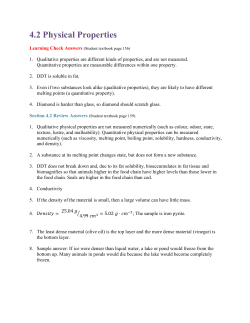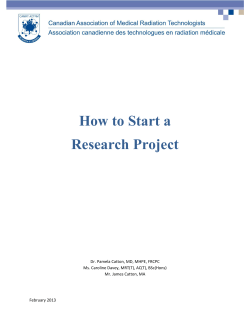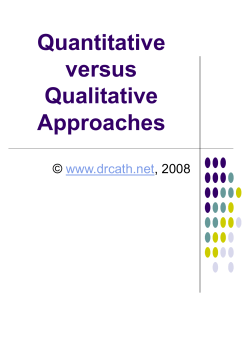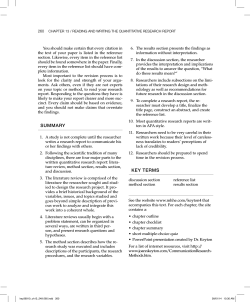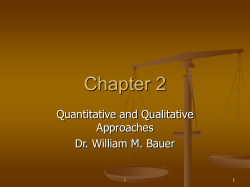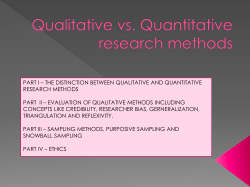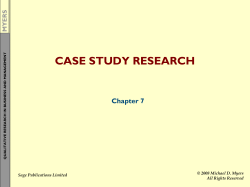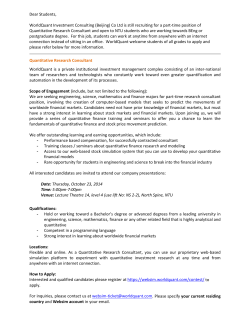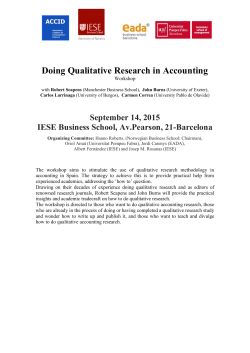
CHAPTER 3 RESEARCH TRADITIONS
CHAPTER 3 RESEARCH TRADITIONS ONTOLOGY AND EPISTEMOLOGY Ontology refers to the philosophy of the existence and nature of phenomena. Epistemology is the branch of philosophy that deals with how knowledge of such phenomena is acquired, and what counts as knowledge. POSITIVISM • Positivism refers to the school of thought that the only ‘true’ or valid form of knowledge is that which is ‘scientific’. • The principles and methods of the natural sciences (such as chemistry or physics) are used to study human behaviour, which in itself is objective and tangible in nature. • The researcher can observe human behaviour and measure ‘facts’, and ‘laws’ or theories of behaviour can be developed. • Concepts such as feelings, emotions, beliefs and so on have no place in research as they cannot be directly observed or measured, they are unreliable and they are not constant over time. • Measurements should be objective. • This approach involves precise measurements, which can be controlled or manipulated by the researcher. • Others could see the same evidence for themselves and reach the same conclusions. • Such exact measurement allows statistical analysis which provides an impartial and precise answer. • Careful research designs can show causal relationships, for example X causes Y. • The researcher has no influence on the findings, and has no personal influence on the results. INTERPRETIVISM Natural scientists, together with the type of philosophers of science who are deeply committed to the belief in the primacy of law-like natural sciences, have used all their intellectual strength and their social power in order to convince others that the ‘method’ of the natural sciences. . . is the only legitimate method of scientific discovery. The defenders of this view, as a rule, have very little experience in social science research. . . It needs to be said, therefore, clearly and unequivocally, that it is possible to advance knowledge and to make discoveries in the field of sociology with methods which can be very different from those of the natural sciences. The discovery, not the method, legitimises research as scientific. (Elias 1986, p.20) • Sport is a social phenomenon, that is those involved in sports are acted upon by a number of external social forces, but also have free will to respond to such forces in an active way, and are not inanimate objects. • We all have, to differing extents, freedom to act in a number of different ways, and positivism does not take into account intangible concepts related to this freedom. • Thus behaviour cannot can be understood in terms of direct causal relationships. • Concepts such as feelings, and emotions form the basis of the interpretative approach. They are not measured numerically – such an approach would argue that these concepts are too complex to be reduced to numbers. • Rather, they are ‘measured’ using words, statements and other non-numerical measures, collecting data from the viewpoint of the participant. • The data is then interpreted by the researcher, who attempts to uncover meanings, values, explanations and so on. • This approach also avoids any search for ‘truth’, instead seeking understanding. QUANTITATIVE DATA • Closely associated with positivist approach. • Data in numerical form. • Involves measurable ‘quantities’. • Often collected on a single occasion. QUALITATIVE DATA • Qualitative research uses non-numerical data. • Data in the form of words that have to be interpreted by the researcher that is relevant. • Aims to capture meanings or qualities that are not quantifiable, such as feelings, thoughts, experiences and so on. • Often collected over an extended time period. Placing a frequency count after a category of experiences is tantamount to saying how important it is; thus value is derived by number. In many cases, rare experiences are no less meaningful, useful, or important than common ones. In some cases, the rare experience may be the most enlightening one. (Krane et al. 1997, p.214) MIXING QUANTITATIVE AND QUALITATIVE DATA I Blending qualitative and quantitative methods of research can produce a final product which can highlight the significant contributions of both. (Nau 1995, p.1) Qualitative data can be used to support and explicate the meaning of quantitative research. (Jayaratne 1993, p.117) MIXING QUANTITATIVE AND QUALITATIVE DATA II Linking types of data provides a way to use statistics, the traditional language of research, along with anecdotes and narratives for further clarity in understanding physical activity involvement. Descriptive statistics do not tell the meanings of physical activity. In-depth interviews alone are not necessarily representative of the sample. Together, however, linking the data gives a bigger picture of some of the issues. (Henderson et al. 1999, p.253) MIXING QUANTITATIVE AND QUALITATIVE DATA III 1. One may facilitate the other – thus a piece of quantitative research may identify the existence of a particular occurrence that could then be explained through the collection of qualitative data. 2. Both approaches investigate the same phenomenon. Quantitative methods may be used to collect relatively simple, or ‘shallow’ numerical data from a large sample, whereas qualitative methods may collect ‘rich’ data from a smaller sample. DEDUCTIVE RESEARCH 1. A statement regarding the theory used to underpin the research. 2. A statement deduced from that theory that would suggest, if the theory is true, the relationship between two or more variables – a hypothesis. 3. Collecting data to test this hypothesis. 4. Using the results to confirm, modify or refute the theory used to develop the hypothesis. INDUCTIVE RESEARCH 1. Collection of data with no prior theory or hypothesis. 2. Analysis of data. 3. Development of theory or explanation from the data. QUESTIONS TO CONSIDER 1. Can I measure the phenomenon I am interested in numerically? Or is this inappropriate? 2. Am I concerned only with measurable ‘facts’? 3. Am I concerned with the individual’s views or explanations of what is happening? 4. Do I think that the ‘truth’ is different for each individual, and that I cannot develop scientific ‘laws’ of behaviour? 5. What would I be happier doing in terms of positivist or interpretative research? If you answer ‘yes’ to the first two and ‘no’ to the next two questions, then you are likely to follow a positivist, quantitative approach. If you responded ‘no’ to the first two and ‘yes’ to the next two, then you are likely to follow an inductive, qualitative approach. SUMMARY 1. Two broad approaches to the nature of knowledge exist – positivism and interpretivism. 2. Positivists adhere to the tenets of the natural sciences and view behaviour as directly measurable and explainable. 3. Interpretivists suggest that individuals have freedom to act in particular ways, and that they experience things differently. Thus, the researcher has to interpret ‘reality’ from each individual’s experiences. SUMMARY 4. Distinctions can also be made between quantitative and qualitative research. Quantitative research is based upon numerical measurement and analysis. Qualitative research is based upon non-numerical analysis of words, feelings, emotions and so on. 5. Research may follow a deductive or an inductive process. Deductive research involves the testing of a predetermined theory, explanation or hypothesis. Inductive research generates the explanation from the data collected.
© Copyright 2025

